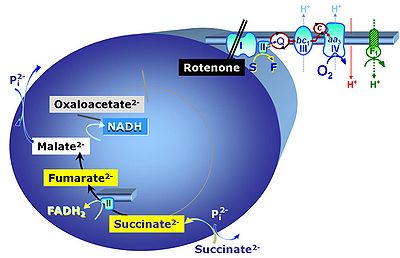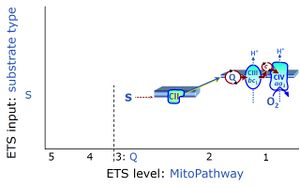Difference between revisions of "Succinate pathway"
m (moved S to S-pathway control) |
|||
| Line 2: | Line 2: | ||
|abbr=S | |abbr=S | ||
|description=[[File:SUIT-catg_S.jpg|right|300px|Succinate]] | |description=[[File:SUIT-catg_S.jpg|right|300px|Succinate]] | ||
[[ | '''S-pathway control''', S, is achieved with [[succinate]] as the single substrate, an [[Categories_of_SUIT_protocols#SUIT-Catg:_single_substrate_type |ETS-level 3 substrate]]: succinate-induced respiratory state; CII-linked; SRot; [[succinate alone]]. S supports electron flux through [[Complex II]] to CII-bound flavin adenine dinucleotide (FADH2) to [[Q]]. Inhibition of Complex I by '''[[rotenone]]''' (Rot; or amytal, piericidine) prevents accumulation of [[oxaloacetate]] which is a potent inhibitor of [[succinate dehydrogenase]]. After inhibition of CI by [[rotenone]], the NADH-linked dehydrogenases become inhibited by the redox shift from NAD<sup>+</sup> to NADH. Succinate dehydrogenase is activated by succinate and ATP, which explains in part the time-dependent increase of respiration in isolated mitochondria after addition of rotenone (first), succinate and ADP. | ||
The '''Complex II-linked substrate state''' is induced in mt-preparations by addition of [[succinate]]&[[rotenone]] (Complex I inhibitor). Succinate is the direct substrate of [[Complex II]] (succinate dehydrogenase). In CII-linked respiration, only Complex III and Complex IV are involved in pumping protons from the matrix (P-phase) to the N-phase with a ~P/O ratio of 1.75 (P/O<sub>2</sub> = 3.5). | |||
|info=[[Gnaiger 2014 MitoPathways |Gnaiger 2014 MitoPathways - Chapter 4.1]], [[Gnaiger 2000 Proc Natl Acad Sci U S A]] | |||
}} | }} | ||
{{MitoPedia concepts | {{MitoPedia concepts | ||
|mitopedia concept=Respiratory state, SUIT state | |mitopedia concept=Respiratory state, SUIT state | ||
}} | |||
[[File:S(Rot).jpg|400px|thumb|Succinate+rotenone, S(Rot). From [[Gnaiger 2014 MitoPathways]].]] | |||
== SRot(L) == | |||
# ~P/O2 ratio: [[Gnaiger 2000 Proc Natl Acad Sci U S A]] | |||
# [[O2k-Protocols]]: [[MiPNet12.11 MitoRespiration]] | |||
# Comparison with [[S alone]], CI<small>&</small>II, and H<sub>2</sub>O<sub>2</sub> production: [[Makrecka-Kuka 2015 Biomolecules]] | |||
== SRot(P) == | |||
# ~P/O2 ratio: [[Gnaiger 2000 Proc Natl Acad Sci U S A]] | |||
# [[O2k-Protocols]]: [[MiPNet12.11 MitoRespiration]] | |||
# Comparison with [[S alone]] CI<small>&</small>II, and H<sub>2</sub>O<sub>2</sub> production: [[Makrecka-Kuka 2015 Biomolecules]] | |||
== SRot(E) == | |||
# [[O2k-Protocols]]: [[MiPNet12.11 MitoRespiration]] | |||
# Comparison with CI-CI<small>&</small>II-CII SUIT protocol: [[Votion 2012 PLoS One]] | |||
# [[SUIT RP1]]_'''7Rot''': 1PM 2D 2c (2NADH) 3U 4Oct 5G 6S '''<u>7Rot</u>''' 8Gp 9Ama 10Tm 11Azd | |||
== List of publications: CII-linked substrate state == | |||
: This list does not distinguish between substrate states for [[Succinate alone]] (without Rot) and SRot. | |||
{{#ask:[[Category:Publications]] [[Substrate states::CII]] | |||
|?Was published in year=Year | |||
|?Has title=Reference | |||
|?Mammal and model | |||
|?Tissue and cell | |||
|?Stress | |||
|?Diseases | |||
|format=broadtable | |||
|limit=5000 | |||
|offset=0 | |||
|sort=Was published in year | |||
|order=descending | |||
}} | }} | ||
Revision as of 16:30, 26 August 2016
Description
S-pathway control, S, is achieved with succinate as the single substrate, an ETS-level 3 substrate: succinate-induced respiratory state; CII-linked; SRot; succinate alone. S supports electron flux through Complex II to CII-bound flavin adenine dinucleotide (FADH2) to Q. Inhibition of Complex I by rotenone (Rot; or amytal, piericidine) prevents accumulation of oxaloacetate which is a potent inhibitor of succinate dehydrogenase. After inhibition of CI by rotenone, the NADH-linked dehydrogenases become inhibited by the redox shift from NAD+ to NADH. Succinate dehydrogenase is activated by succinate and ATP, which explains in part the time-dependent increase of respiration in isolated mitochondria after addition of rotenone (first), succinate and ADP.
The Complex II-linked substrate state is induced in mt-preparations by addition of succinate&rotenone (Complex I inhibitor). Succinate is the direct substrate of Complex II (succinate dehydrogenase). In CII-linked respiration, only Complex III and Complex IV are involved in pumping protons from the matrix (P-phase) to the N-phase with a ~P/O ratio of 1.75 (P/O2 = 3.5).
Abbreviation: S
Reference: Gnaiger 2014 MitoPathways - Chapter 4.1, Gnaiger 2000 Proc Natl Acad Sci U S A
MitoPedia concepts:
Respiratory state,
SUIT state

SRot(L)
- ~P/O2 ratio: Gnaiger 2000 Proc Natl Acad Sci U S A
- O2k-Protocols: MiPNet12.11 MitoRespiration
- Comparison with S alone, CI&II, and H2O2 production: Makrecka-Kuka 2015 Biomolecules
SRot(P)
- ~P/O2 ratio: Gnaiger 2000 Proc Natl Acad Sci U S A
- O2k-Protocols: MiPNet12.11 MitoRespiration
- Comparison with S alone CI&II, and H2O2 production: Makrecka-Kuka 2015 Biomolecules
SRot(E)
- O2k-Protocols: MiPNet12.11 MitoRespiration
- Comparison with CI-CI&II-CII SUIT protocol: Votion 2012 PLoS One
- SUIT RP1_7Rot: 1PM 2D 2c (2NADH) 3U 4Oct 5G 6S 7Rot 8Gp 9Ama 10Tm 11Azd
List of publications: CII-linked substrate state
- This list does not distinguish between substrate states for Succinate alone (without Rot) and SRot.

